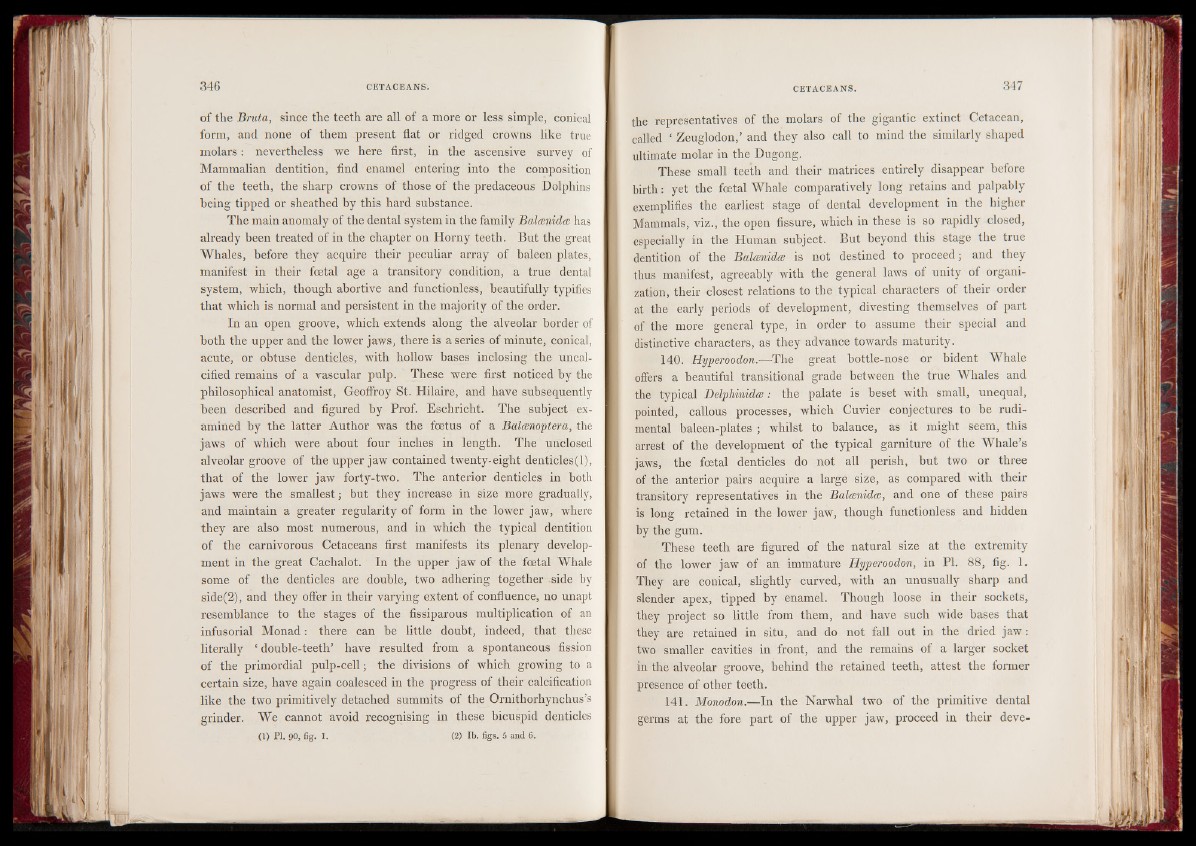
of the Bruta, since the teeth are all of a more or less simple, conical
form, and none of them present flat or ridged crowns like true
molars : nevertheless we here first, in the ascensive survey of
Mammalian dentition, find enamel entering into the composition
of the teeth, the sharp crowns of those of the predaceous Dolphins
being tipped or sheathed by this hard substance.
The main anomaly of the dental system in the family Baloenidoe has
already been treated of in the chapter on Horny teeth. But the great
Whales, before they acquire their peculiar array of baleen plates,
manifest in their foetal age a transitory condition, a true dental
system, which, though abortive and functionless, beautifully typifies
that which is normal and persistent in the majority of the order.
In an open groove, which extends along the alveolar border of
both the upper and the lower jaws, there is a series of minute, conical,
acute, or obtuse denticles, with hollow bases inclosing the uncalcified
remains of a vascular pulp. These were first noticed by the
philosophical anatomist, Geoffroy St. Hilaire, and have subsequently
been described and figured by Prof. Eschricht. The subject examined
by the latter Author was the foetus of a Baloenoptera, the
jaws of which were about four inches in length. The unclosed
alveolar groove of the upper jaw contained twenty-eight denticles(l),
that of the lower jaw forty-two. The anterior denticles in both
jaws were the smallest ; but they increase in size more gradually,
and maintain a greater regularity of form in the lower jaw, where
they are also most numerous, and in which the typical dentition
of the carnivorous Cetaceans first manifests its plenary development
in the great Cachalot. In the upper jaw of the foetal Whale
some of the denticles are double, two adhering together side by
side(2), and they offer in their varying extent of confluence, no unapt
resemblance to the stages of the fissiparous multiplication of an
infusorial Monad : there can be little doubt, indeed, that these
literally ‘ double-teeth’ have resulted from a spontaneous fission
of the primordial pulp-cell ; the divisions of which growing to a
certain size, have again coalesced in the progress of their calcification
like the two primitively detached summits of the Ornithorhynchus’s
grinder. We cannot avoid recognising in these bicuspid denticles
(1) PI. 90, fig. 1. (2) lb. figs. 5 and 6.
the representatives of the molars of the gigantic extinct Cetacean,
called ‘ Zeuglodon,’ and they also call to mind the similarly shaped
ultimate molar in the Dugong.
These small teeth and their matrices entirely disappear before
birth : yet the foetal Whale comparatively long retains and palpably
exemplifies the earliest stage of dental development in the higher
Mammals, viz., the open fissure, which in these is so rapidly closed,
especially in the Human subject. But beyond this stage the true
dentition of the Baloenidoe is not destined to proceed ; and they
thus manifest, agreeably with the general laws of unity of organization,
their closest relations to the typical characters of their order
at the early periods of development, divesting themselves of part
of the more general type, in order to assume their special and
distinctive characters, as they advance towards maturity.
140. Hyperoodon.—The great bottle-nose or hident Whale
offers a beautiful transitional grade between the true Whales and
the typical Delphinidoe : the palate is beset with small, unequal,
pointed, callous processes, which Cuvier conjectures to be rudi-
mental baleen-plates ; whilst to balance, as it might seem, this
arrest of the development of the typical garniture of the Whale’s
jaws, the foetal denticles do not all perish, but two or three
of the anterior pairs acquire a large size, as compared with their
transitory representatives in the Baloenidoe, and one of these pairs
is long retained in the lower jaw, though functionless and hidden
by the gum.
These teeth are figured of the natural size at the extremity
of the lower jaw of an immature Hyperoodon, in PL 88, fig. 1.
They are conical, slightly curved, with an unusually sharp and
slender apex, tipped by enamel. Though loose in their sockets,
they project so little from them, and have such wide bases that
they are retained in situ, and do not fall out in the dried jaw :
two smaller cavities in front, and the remains of a larger socket
in the alveolar groove, behind the retained teeth, attest the former
presence of other teeth.
141. Monodon.—In the Narwhal two of the primitive dental
germs at the fore part of the upper jaw, proceed in their deve